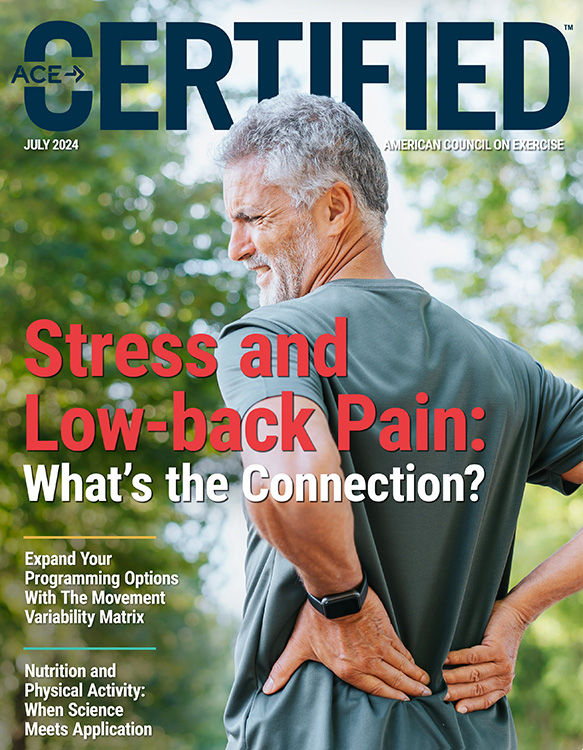
The Impact of Exercise on Depression: A Guide for Health and Exercise Professionals

Key Findings
- For treating depression, various exercise types are both well tolerated and effective.
- Walking or jogging, yoga and strength training appeared to be most effective in reducing symptoms of depression.
- The effects of exercise were comparable to psychotherapy and pharmacotherapy.
- The more intense the exercise, the greater the effect in reducing symptoms of depression.
Exercise has long been touted as a beneficial intervention for alleviating symptoms of depression, but which types of exercise are most effective? A recent meta-analysis sheds light on this question, offering insights into how various forms of physical activity can reduce the severity of depression. This article explores the study’s findings and offers practical advice on how to share this valuable information with your clients.
The meta-analysis investigated the impact of different exercise types on depression severity, which was assessed using several validated questionnaires. The study included more than 14,000 participants who had been diagnosed with major depressive disorder (MDD) or those who exceeded the clinical threshold for depression on diagnostic questionnaires. The researchers included data from 218 randomized controlled trials that assesse various types of exercise, including dance, walking/jogging, yoga, strength training, mixed aerobic exercise, tai chi/qigong and cycling, and compared them to the use of psychotherapy, antidepressants, and active control conditions.
Effectiveness of Different Exercises
The analysis revealed that all exercise types reduced depression severity, with walking or jogging, yoga and strength training being the most well tolerated and effective. Additionally, all types of exercise were as effective or more effective than the use of selective serotonin reuptake inhibitors (SSRIs), which are the most prescribed antidepressants, and approximately as effective as cognitive behavioral therapy (CBT). Additionally, all exercise types were more effective than active controls.
As is often the case, the study found that the benefits of exercise were greater when the exercise was more intense. For example, running appeared to be more effective than walking. However, more intense exercise is often more challenging for individuals to stick with, so consistency is likely more important than intensity. In other words, the most effective exercise is the one a person will do on a regular exercise. Interestingly, dropout rates were lowest with strength training and yoga.
Exercise is thought to improve depression symptoms through several mechanisms, including stimulating neuroplasticity, which involves the brain's ability to create and strengthen neural pathways. This may help redirect focus from negative thoughts (rumination) to more positive ones.
Practical Application for Health and Exercise Professionals
Sharing these findings with clients can empower them to take an active role in managing their mental health through physical activity. Here are some practical ways to communicate this information effectively:
First, personalize recommendations based on client preferences and current fitness levels. For instance, if a client enjoys dancing, suggest dance-based workouts, which were found to be effective. Highlighting enjoyment is crucial for adherence, so encourage clients to choose exercises they find fun and engaging. For example, walking with a friend or joining a group fitness class can enhance the social and enjoyable aspects of exercise.
Help your clients set realistic goals. Encourage them to start with manageable goals and gradually increase intensity to help build their confidence and see progress, which can reduce their risk of dropout. A beginner could start with short walks and gradually incorporate jogging intervals. Incorporating variety in exercise routines can also prevent boredom and keep clients motivated. A mix of aerobic exercises, strength training and yoga can provide comprehensive benefits.
Take time to address any barriers to exercise your client may be facing. Understand and address barriers, such as lack of motivation or physical limitations, by offering practical solutions. Home workouts can be great for clients with busy schedules, while modified exercises can cater to those with physical restrictions. Regularly monitoring progress and adjusting the exercise program as needed is important. And don’t forget to celebrate even small achievements, which can serve to boost morale and adherence and reinforce the positive impact of exercise on a client’s mental health.
This meta-analysis confirms that different types of exercises can significantly reduce depression severity. As health and exercise professionals, sharing these findings with your clients can empower them to take an active role in managing their mental health through physical activity. By personalizing recommendations, focusing on enjoyment, setting realistic goals and addressing barriers, you can help clients incorporate effective exercise routines into their lives, ultimately improving their mental well-being.
Integrating these insights into your practice can better support your clients in achieving both their physical and mental health goals. By understanding and applying the findings of this meta-analysis, you can enhance the effectiveness of your exercise programs and make a meaningful difference in your clients' lives.
Expand Your Knowledge
A Holistic Approach to Mental Health
As the conversation around mental health grows, health and exercise professionals have an exciting opportunity to positively impact people’s mental well-being and overall health through services and programming while staying within their scope of practice. This course offers insight from five industry experts who share their knowledge about various factors of wellness that can impact your clients’ mental health. Through each session, you’ll learn how to expand your offerings and assist your clients in their quest for better mental health and well-being.
Caring for Yourself While Supporting Others
You spend your days caring for the wellness of others, yet making time for your comprehensive health can be hard. Do you find yourself feeling burnt out or in a rut? Even with the advanced knowledge and skills you hold, addressing your well-being may not be easy. This course explores the unique challenges health and exercise pros can experience and validate that you are not alone. You will learn how to reflect on your own comprehensive well-being and use targeted behavior change principles and motivation concepts to better care for yourself and your clients.

More Articles
- Certified™: July 2024
Expand Your Programming Options With the Movement Variability Matrix
Contributor
- Certified™: July 2024
Nutrition and Physical Activity: When Science Meets Application
Contributor




 by
by 



